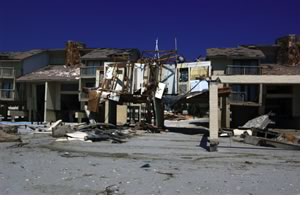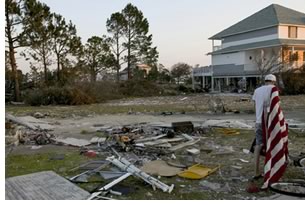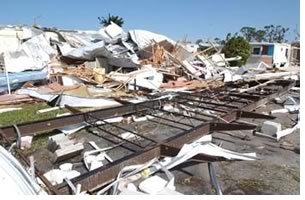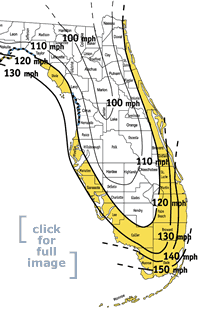

10/2004
As weary Floridians this week grapple yet again with a devastating storm, officials are gathering reports on the efficacy of code changes made after Hurricane Andrew struck in 1992. In the wake of Hurricanes Charlie, Frances, and Ivan, the news so far is positive: Buildings constructed under the new code guidelines have fared better than their older counterparts. Although much evidence remains to be gathered as this disastrous hurricane season wears on, officials are optimistic that the processes put in place in the 1990s serve as a good starting point for the ongoing cycle of code considerations.
Architects are designing buildings differently now with post-Hurricane
Andrew code revisions, particularly provisions that call for stronger
protection against high winds for homes built along the Florida coast.
These include requirements for storm shutters, impact-resistant glass,
or enhanced pressure-resistant design. Areas affected by the code include
those portions of the state that have been hit by 120-mile-per-hour,
50- to 100-year peak wind gusts.
“We always have had the ability to tie a structure down, although
not many jurisdictions required it. If you happened to know you were
in a very bad location you might have done it,” says David S.
Collins, FAIA, the AIA’s codes consultant. As to the recent storms, “To
what degree changes will be implemented or found to be necessary, it’s
way too early to speculate. I
haven’t seen any reports yet on what the pattern of damage is or
if there is one.”
 Collins explains that in the past, various study teams went to Florida
to analyze the damage and how it occurred, and to ascertain the probable
causes of the losses. Then ad-hoc committees on wind-load design from
all the model code groups, but principally through the Southern Building
Code Congress International, looked at the loss issues identified by
FEMA and developed various criteria to try to address those problems.
For example, some of the changes were as simple as requiring that the
nailing of the roof sheathing be inspected. “We all sort of assumed
that was being done in the past. The schedule was all part of the code,
but a lot of investigations found that there was a lack of actual execution
in the field,” Collins says. “There was a lot more emphasis
put on the inspection process of nailing sheathing and anchoring those
roof structures to the walls.”
Collins explains that in the past, various study teams went to Florida
to analyze the damage and how it occurred, and to ascertain the probable
causes of the losses. Then ad-hoc committees on wind-load design from
all the model code groups, but principally through the Southern Building
Code Congress International, looked at the loss issues identified by
FEMA and developed various criteria to try to address those problems.
For example, some of the changes were as simple as requiring that the
nailing of the roof sheathing be inspected. “We all sort of assumed
that was being done in the past. The schedule was all part of the code,
but a lot of investigations found that there was a lack of actual execution
in the field,” Collins says. “There was a lot more emphasis
put on the inspection process of nailing sheathing and anchoring those
roof structures to the walls.”
Moving toward IBC
After Hurricane Andrew, the Florida legislature passed a bill to enact
a uniform statewide code administered at the local level, explains
Raul Rodriguez, AIA, a Miami architect and chair of the Florida Building
Commission. “And before this hurricane season, we had already
started the first three-year review process,” he says. “We’re
changing the template of the code from the Standard Building Code to
the International Building Code (IBC).”
 When the commission started its previous code-revision cycle, the IBC
was not ready, Rodriguez explains. They instead adopted the Standard
Building Code with Florida-specific amendments. Rodriguez reports that
in the past few months, “We have already learned that homes built
under that March 2001 Florida Building Code have performed better and
admirably. We have also learned that the mobile homes have not done very
well.”
When the commission started its previous code-revision cycle, the IBC
was not ready, Rodriguez explains. They instead adopted the Standard
Building Code with Florida-specific amendments. Rodriguez reports that
in the past few months, “We have already learned that homes built
under that March 2001 Florida Building Code have performed better and
admirably. We have also learned that the mobile homes have not done very
well.”
More lessons will be gathered as investigations continue. “We have already invited individuals and every organization putting together scientific findings of the lessons learned to come before the commission to discuss how we might take advantage of their information,” Rodriguez says.
New code next year
The commission already has decided that the new code, due out in January
2005, will be issued a few months later to allow this extra information
to be evaluated. Local municipalities may amend the code, provided
that they show specific need and a cost analysis to justify the extra
expense. “Hurricane Andrew was a life-changing experience for
the people of Miami, Dade, and Broward, the way Charlie is now for
Punta Gorda, and Ivan for the Panhandle. I’m sure that lessons
learned will result in Florida-specific measures for the future,” Rodriguez
says.
Miami architect Larry Schneider, AIA, a member of the AIA Codes and Standards Committee, past chair of the Florida Board of Building Codes and Standards, and an active participant in commission activities, speculates that the new code will increase the wind-load requirements for certain areas of the state. But, he cautions, the important part of dealing with code changes is “not to be emotional in upgrading the code and reacting to what is an anomaly without knowing the facts.” Schneider also advises against a bunker mentality. “At what time do you design for the ultimate catastrophe? You need to make the design and code decisions based on the facts that are provided when you do an investigation in the wake of a storm.”
 Life-changing events
Life-changing events
“In a quantitative society like ours, people tend to favor quantity
over quality. Marketing is usually directed to ‘how many square feet’ and
not always directed at design or structural integrity,” Rodriguez
says. But, he acknowledges, values changed in Dade County after 1992. With
the focus on life-safety issues, he says people are beginning to ask, ‘Who
designed this house? Under which code was it built? Who was the contractor?
“If people ask for it, the market will provide it. There was a
time when cars didn’t have seat belts and air bags. You can only
appreciate the value of a roll bar when your car has rolled over,” Rodriguez
asserts. “These are life-changing events. You only have so much
money to work with, so perhaps it’s a matter of trading a Jacuzzi
for a strong structure. I think the quantitative-vs.-qualitative question
becomes more real to people.”
 Praising the process
Praising the process
Rodriguez praises the consensus process that has resulted in the code
decisions thus far. “I am absolutely in awe of this process,” says
the Democrat appointed by Republican Gov. Jeb Bush to serve as the
commission’s chair. “The intent is not to compromise, because
one does not compromise on issues of life safety, but to find and reach
consensus on the best way to achieve results the people want.”
Rodriguez, who has served as chair for five years, notes that the 24-member commission, with stakeholders from many disciplines, voted to require a 75-percent majority to pass any motions. Rodriguez says the process is fair almost to the point of exhaustion, but, were he to characterize the atmosphere in one word, it would be “respect.”
“It’s always an asset that architects—I’m biased, of course—tend to be balanced between right brain and left brain so they’re natural consensus-builders and problem-solvers,” he concludes. “You can find disagreement amongst people in any profession, but in this process of looking out for the best interest of the public with respect to the built environment, I think architects have already stepped up and will continue to step up.”
Copyright 2004 The American Institute of Architects.
All rights reserved. Home Page ![]()
![]()
 |
||
|
||
